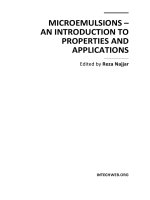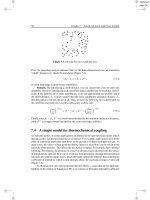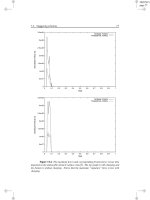MICROEMULSIONS – AN INTRODUCTION TO PROPERTIES AND APPLICATIONS potx
Bạn đang xem bản rút gọn của tài liệu. Xem và tải ngay bản đầy đủ của tài liệu tại đây (8.74 MB, 262 trang )
MICROEMULSIONS –
AN INTRODUCTION TO
PROPERTIES AND
APPLICATIONS
Edited by Reza Najjar
Microemulsions – An Introduction to Properties and Applications
Edited by Reza Najjar
Published by InTech
Janeza Trdine 9, 51000 Rijeka, Croatia
Copyright © 2012 InTech
All chapters are Open Access distributed under the Creative Commons Attribution 3.0
license, which allows users to download, copy and build upon published articles even for
commercial purposes, as long as the author and publisher are properly credited, which
ensures maximum dissemination and a wider impact of our publications. After this work
has been published by InTech, authors have the right to republish it, in whole or part, in
any publication of which they are the author, and to make other personal use of the
work. Any republication, referencing or personal use of the work must explicitly identify
the original source.
As for readers, this license allows users to download, copy and build upon published
chapters even for commercial purposes, as long as the author and publisher are properly
credited, which ensures maximum dissemination and a wider impact of our publications.
Notice
Statements and opinions expressed in the chapters are these of the individual contributors
and not necessarily those of the editors or publisher. No responsibility is accepted for the
accuracy of information contained in the published chapters. The publisher assumes no
responsibility for any damage or injury to persons or property arising out of the use of any
materials, instructions, methods or ideas contained in the book.
Publishing Process Manager Ivona Lovric
Technical Editor Teodora Smiljanic
Cover Designer InTech Design Team
First published March, 2012
Printed in Croatia
A free online edition of this book is available at www.intechopen.com
Additional hard copies can be obtained from
Microemulsions – An Introduction to Properties and Applications,
Edited by Reza Najjar
p. cm.
ISBN 978-953-51-0247-2
Contents
Preface IX
Part 1 Introduction 1
Chapter 1 Microemulsions – A Brief Introduction 1
Reza Najjar
Part 2 Microstructures: Experimental and Modeling Studies 31
Chapter 2 Ultrasonic Characterisation of W/O Microemulsions –
Structure, Phase Diagrams, State of Water in
Nano–Droplets, Encapsulated Proteins, Enzymes 33
Vitaly Buckin and Shailesh Kumar Hallone
Chapter 3 Influence of Linear Aliphatic Alcohols upon the Electric
Percolation of AOT-Based Microemulsions 67
A. Cid, J.A. Manso, J.C. Mejuto and O.A. Moldes
Chapter 4 Predictive Modeling of Microemulsion Phase Behaviour and
Microstructure Characterisation in the 1-Phase Region 83
Deeleep K. Rout, Richa Goyal, Ritesh Sinha,
Arun Nagarajan and Pintu Paul
Part 3 Applications in Drug Delivery and Vaccines 113
Chapter 5 Nonionic Model Microemulsions to Study Interactions with
Active Components and Antioxidant Activity 115
Joakim Balogh, Luís Marques and António Lopes
Chapter 6 Thermal Reversible Microemulsion for Oral
Delivery of Poorly Water-Soluble Drugs 135
Zhong-Gao Gao
Chapter 7 The Mucosal Immune System:
Modulation by Microemulsion 151
Eduardo Luzia França and Adenilda Cristina Honorio-França
VI Contents
Part 4 Applications in Oil Industry and
Preparation of Nanostructured Materials 159
Chapter 8 The Use of Microemusion Systems in Oil Industry 161
Vanessa Cristina Santanna, Tereza Neuma de Castro Dantas
and Afonso Avelino Dantas Neto
Chapter 9 Mesostructured Polymer Materials Based
on Bicontinuous Microemulsions 175
Masashi Kunitake, Kouhei Sakata and Taisei Nishimi
Chapter 10 Microemulsion Method for Synthesis
of Magnetic Oxide Nanoparticles 191
A. Drmota, M. Drofenik, J. Koselj and A. Žnidaršič
Chapter 11 Synthesis of Nanocatalysts via Reverse
Microemulsion Route for Fischer-Tropsch Reactions 215
N.A. Mohd Zabidi
Chapter 12 Nanoparticles Preparation Using
Microemulsion Systems 229
Anna Zielińska-Jurek, Joanna Reszczyńska,
Ewelina Grabowska and Adriana Zaleska
Preface
Microemulsions are thermodynamically stable mixtures composed of at least three
components, namely, oil, water and surfactant, and sometimes a fourth component
called as co-surfactant essentially comes into play. This field is one of the still rapidly
growing fields of science and technology that have attracted a great attention of the
scientists with various professions, ranging from pure physical chemists to oil engineers,
pharmacologists and biologists. Besides many researchers investigating the structural
and pure scientific aspects of these systems by different tools and techniques, there are a
lot of others benefiting them as a powerful and vital tool to achieve own aims. Regarding
these facts, the investigation and work either on the scientific or application aspects of
microemulsions still is a high priority research theme.
This book was intended to provide an insight into the fundamentals and some
applications of microemulsion systems. In the first Chapter, a very short introduction
about the background and general aspects of microemulsions is given. The author has
tried to introduce different types of related fields and provide some reviews and
original references to enter the reader into the play.
The second Part of the book was assigned for investigating the influence of some
determining parameters on the microstructure and phase behavior of these systems. In
Chapter 2 of the book, Dr Buckin one of the prominent experts in this special field has
provided a new aspects in investigation of microemulsion characteristics, such as size,
microstructure and state of water in nano-droplets and … with high-resolution
ultrasonic measurements. The third Chapter of the book by Dr Cid and co-authors deals
with the effect of changing the size and type of co-surfactants on the electric percolation
and percolation temperature of the system. In Chapter 4, Dr Rout and co-authors have
discussed on another aspect of the microemulsion science, and used one of the well
known theoretical models already proposed for the description of the microemulsions, to
predict phase behavior and microstructure of a system in 1-phase region.
In Part 3 and Part 4 of the book different type of applications of the microemulsions
have been explained. Among the applications of microemulsions, their use in drug
delivery systems and vaccines have gained a great interest during the last decade. One
of the challenges in this field is to develop some common “ready to use” drug delivery
systems where one only needs to add an active component to formulation. Dr Balogh
in Chapter 5 has presented if it is really as simple as to add any active component and
X Preface
use them or further work will be required with these formulations. The next Chapter
deals with the work on a thermal reversible system for delivering of poorly water-
soluble drugs by oral administration. Dr Gao has discussed on the different
parameters affecting the oral delivery of the lypophilic drugs by the mentioned
system. In the Chapter 7, the improvement of the vaccination methods using
microemulsions has been demonstrated. Dr França and co-author have explained the
beneficial effect of using nanoparticles for vaccine delivery via microemulsions
resulting in good immune responses.
The last Part of the book is devoted to their use in oil industry as an old and important
application, as well as the other main type of microemulsion applications, namely, use
of them in preparation of the nanostructured materials, which has become very
popular during last decade. Dr Santanna and co-authors have described how several
microemulsion systems which may be used in different areas of the oil industry, such
as wells hydraulic fracturing, corrosion inhibitors in pipelines, in the breakdown of
water/oil emulsions, in enhanced oil recovery, and as alternative fuel. In Chapter 9, Dr
Kunitake and co-authors have introduced use of microemulsions with bicontinuous
microstructures as a template for preparation of the continuous porous polymeric
materials and bicontinuous hybrid materials by polymerization or gelation. In Chapter
10, another type of microemulsion applications, i.e., use of microemulsions with water
in oil droplets as nanoreactors for the preparation of the nanostructured materials is
investigated. Dr Dromta and co-authors have discussed on the preparation of the
magnetic core-shell nanoparticles with a narrow particle size distribution. As
described in Chapter 11 by Dr Mohd Zabidi, use of microemulsion technique was able
to produce Co-based nanocatalysts with a good selectivity in Fischer-Tropsch
reactions. The use of microemulsion systems in preparation of the photocatalysts is
one of the other widely used applications. In the Chapter 12 Dr Zielińska-Jurek and co-
authors have reviewed this field and discussed about the different factors affecting the
properties of prepared photocatalysts.
Finally, I would like to express my gratitude to Mrs Ivona Lovric, the publishing
process manager and Intech Open Access publisher for their efforts in the publishing
process. Many thanks also to my family and families of all other collaborators for their
patience and acceptance of the lost evenings. I wish that this book can give an insight
into the field.
With the best wishes
Marvdizaj, 2012
Dr Reza Najjar
Assistant Professor of Chemistry,
Faculty of Chemistry,
University of Tabriz,
Tabriz,
Iran
Part 1
Introduction









